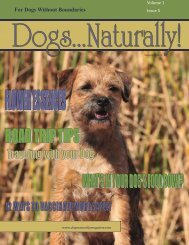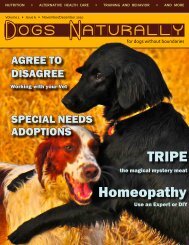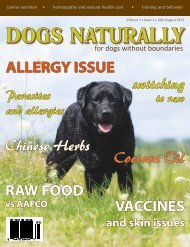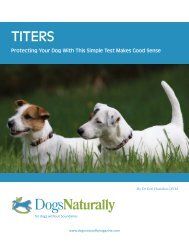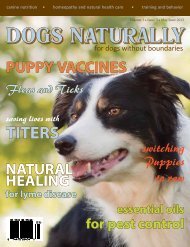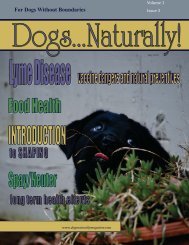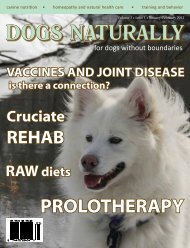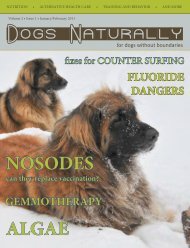For Dogs Without Boundaries - Dogs Naturally Magazine
For Dogs Without Boundaries - Dogs Naturally Magazine
For Dogs Without Boundaries - Dogs Naturally Magazine
Create successful ePaper yourself
Turn your PDF publications into a flip-book with our unique Google optimized e-Paper software.
effects, their relatively immature immune<br />
systems may he temporarily or<br />
more permanently harmed from such<br />
antigenic challenges. Consequences in<br />
later life may be the increased susceptibility<br />
to chronic debilitating diseases.<br />
Some veterinarians trace the increasing<br />
current problems with allergic and immunological<br />
diseases to the introduction<br />
of MLV vaccines some 20 years ago.<br />
While other environmental factors no<br />
doubt have a contributing role, the introduction<br />
of these vaccine antigens and<br />
their environmental shedding may provide<br />
the final insult that exceeds the immunological<br />
tolerance threshold of some<br />
individuals in the pet population<br />
Vaccine Dosage<br />
Manufacturers of MLV combination vaccines<br />
recommend using the same dose<br />
for animals of all ages and different<br />
sizes. It has never made any sense to<br />
vaccinate toy and giant breed puppies (to<br />
choose two extremes) with the same<br />
vaccine dosage. While these products<br />
provide sufficient excess of antigen for<br />
the average sized animal, it is likely to be<br />
either too much for the toy breeds or<br />
too little for the giant breeds. In addition,<br />
combining certain specific viral antigens<br />
such as distemper with adenovirus 2<br />
(hepatitis) has been shown to influence<br />
the immune system by reducing lymphocyte<br />
numbers and responsiveness.<br />
Hormonal State During Vaccination<br />
Relatively little attention has been paid<br />
to the hormonal status of the patient at<br />
the time of vaccination. While veterinarians<br />
and vaccine manufacturers are<br />
aware of the general rule not to vaccinate<br />
animals during any period of illness,<br />
the same principle should apply to times<br />
of physiological hormonal change. This<br />
is particularly important because of the<br />
known role of hormonal change alone<br />
with infectious agents in triggering autoimmune<br />
disease. Therefore, vaccinating<br />
animals at the beginning of, during, or<br />
immediately after an estrous cycle is<br />
unwise, as would he vaccinating animals<br />
during pregnancy or lactation. In this<br />
latter situation, adverse effects can accrue<br />
not only to the dam but also because<br />
a newborn litter is exposed to shed<br />
vaccine virus. One can even question the<br />
wisdom of using MLV vaccines on adult<br />
animals in the same household because<br />
of exposure of the mother and her litter<br />
to shed virus.<br />
Recent studies with MLV heroes virus<br />
vaccines in cattle have shown them to<br />
induce necrotic changes in the ovaries of<br />
heifers that were vaccinated during estrus.<br />
The vaccine strain of this virus was<br />
also isolated from control heifers that<br />
apparently became infected by sharing<br />
the same pasture with the vaccinates.<br />
Furthermore, vaccine strains of these<br />
viral agents are known to be causes of<br />
abortion and infertility following herd<br />
vaccination programs. If one extrapolates<br />
these findings from cattle to the dog, the<br />
implications are obvious.<br />
Killed Versus Modified Live Vaccines<br />
Most single and combination canine<br />
vaccines available today are of MLV origin.<br />
This is based primarily on economic<br />
reasons and the belief that they produce<br />
more sustained protection. A longstanding<br />
question remains, however,<br />
concerning the comparative safety and<br />
efficacy of MLV versus killed<br />
(inactivated) virus vaccines. A recent<br />
examination of the risks posed by MLV<br />
vaccines concluded that they are intrinsically<br />
more hazardous than inactivated<br />
products.<br />
The residual virulence and environmental<br />
<strong>Dogs</strong>...<strong>Naturally</strong>! January/February 2010 | 40



